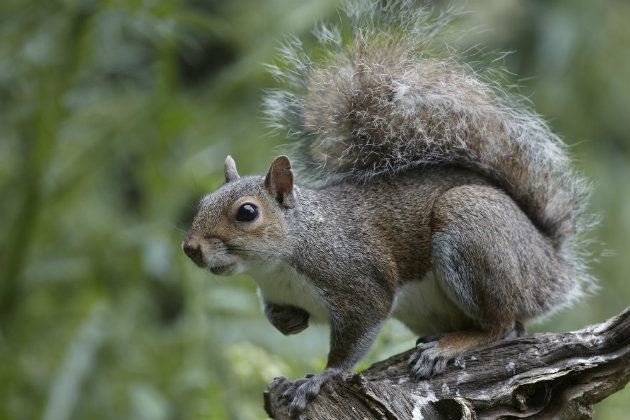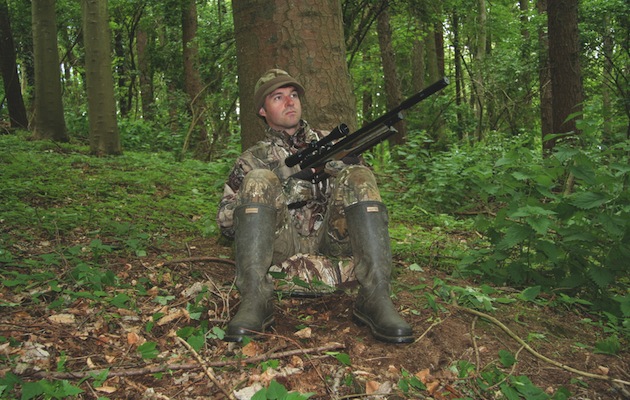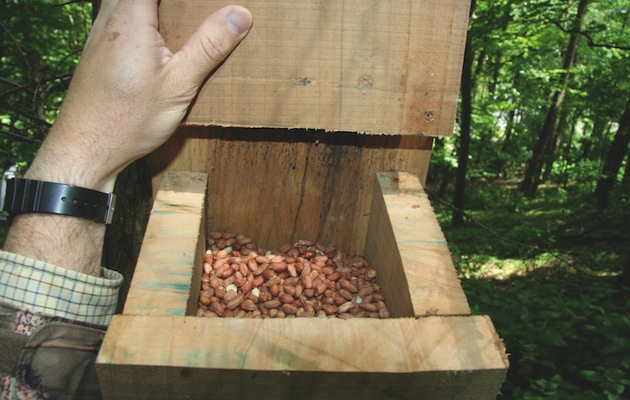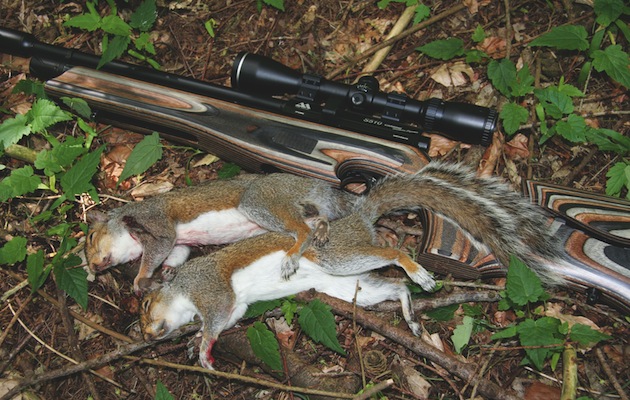Airguns and summer squirrel shooting
Mat Manning offers some advice for luring them into your sights ...

Come the summer months when the trees are in leaf you’re likely to find squirrel shooting with an air rifle rather trickier than in winter on bare branches. The dense foliage covering the tree canopy can make greys almost invisible.
So what’s to be done about it? How can you carry out essential pest control when the leaves are full and green? In winter you can just perch near a pheasant feeder and watch the squirrels arrive. Come May and it’s not so simple.

Airguns really come into their own for squirrel shooting, especially when fitted with a sound moderator
Squirrel shooting with an air rifle
I decided to create a squirrel-feeding station of my own to attract the pests.
The obvious bait seemed to be peanuts.From time to time, I am called upon to deal with squirrels that are making a nuisance of themselves in people’s gardens. The offending bushy-tails are usually concentrated around the bird feeders, where they enjoy a free meal of peanuts. Indeed, many of the squirrels I have shot in my own garden have been picked off while raiding the hanging nut feeders.

The wooden hopper’s contents spill onto a small trough in front of a hole at the base, creating honeypot areas in which squirrels can be targeted
Taking the bait
My initial attempts at fixing shallow wooden trays to trees brought some success, but their limited capacity meant they were quickly emptied and the constant trips to top them up became a nuisance. So, over the past couple of years, I’ve been using a wooden hopper. It’s a simple box that, once loaded with peanuts, gradually spills its contents into a small trough in front of a hole at the base, courtesy of gravity. These boxes can easily be set up and moved from tree to tree, and only need filling once or twice a week, depending on the number of squirrels in the vicinity. So far, they have given excellent results, enabling me to create honeypot areas where I can target squirrels throughout the year.
Setting up
Apart from being useful in the summer when squirrel shooting with an air rifle, the feeders also mean that I can set up feeding stations in woods that are not used by pheasant shoots and where I’m unable to depend on the lure of the gamekeeper’s grain. The only downside is that squirrels are inclined to chew through the wooden box, with the result that the front section needs to be replaced from time to time. I’m trying to persuade a friend to knock up a metal version in order to overcome the problem.
What are the best guns and ammo for shooting grey squirrels?
Squirrels offer the opportunity to match a variety of guns and techiques — it all depends on the squirrelling, says…
I try to set up my feeders in areas where the squirrels are present in high concentrations, identified either by seeing squirrels or their dreys, or by locating the tree species they like best. The feeder is then set up about 5ft off the ground. This is high enough to keep it out of the way of badgers but low enough for me to top up without any great difficulty.
Hiding place
I sometimes go to the trouble of building a hide, but it’s not usually necessary, as incoming squirrels are more distracted by the urge to fill their bellies than the threat of lurking shooters. Settle down in the shadows with a decent backdrop and you’ll probably go unnoticed. Make sure you have a clear view of the feeder. You need to find a hiding place where you’ll be able to pick off squirrels from between 20m and 30m away, depending on your marksmanship, and which has a safe backstop. It’s worth considering these factors and settling on a spot before you fasten your feeder to a tree.
Squirrels are quick to notice changes in their surroundings and will usually start visiting peanut feeders within a day or two of them being set up. I have sometimes used trailcams to keep tabs on the number and frequency of visits. I was pleasantly surprised by the sheer variety of wild birds that dropped in to help themselves to the peanuts. However you don’t have to do this. Squirrels are quite messy feeders and their raids are usually indicated by a scattering of nutty scraps beneath the hopper.
The greys arrive
For the first few days, small birds such as blue tits, nuthatches and chaffinches are the most frequent visitors, with jays soon joining the banquet. It is apparent that the flurry of feathered diners eventually catches the attention of the resident squirrels, which quickly muscle in on the feast. Squirrels are bullish around any kind of feeding opportunity and it’s surprising how quickly the birds back off once the greys arrive in numbers. These invasive rodents don’t just feed on eggs and the young of woodland birds, they also deprive the adults of nourishment.

Squirrels deprive adult birds of nourishment
How long should you wait?
Be patient and don’t reach for your air rifle just yet. Squirrels will attract more of their fellows as they scamper back and forward to the feeder. Six to 10 days is usually about right — if there’s no sign of visiting squirrels after a fortnight, the feeder should be moved.
Once the squirrels are enjoying the peanuts you’re on your way to a good bag. Ideally, you want to slip into position just before dawn so you can intercept incoming greys when they venture out for their dawn binge. The feeder will usually attract a steady trickle of squirrels throughout the day once they have a taste for the peanuts — bed-heads may take a few more visits to mop up the squirrels than the early risers, but you’ll still get some shots.
Airguns really come into their own with this sort of pest control, especially when fitted with a sound moderator. The pap from the muzzle of a silenced pre-charged pneumatic is barely audible, so squirrels are unlikely to be discouraged by the sound of your shots. I’ve had as many as seven in an hour.
My experience of all this is that it takes around three or four visits before it’s time to move the feeder and try somewhere else. By then you should expect to have bagged between six and 15 squirrels – my best so far is 21 from a single feeder – depending on how many there are in the locality.
It’s interesting that the birds come back to the peanuts after the squirrels have been culled. Which shows how important it is to keep squirrel numbers down.












